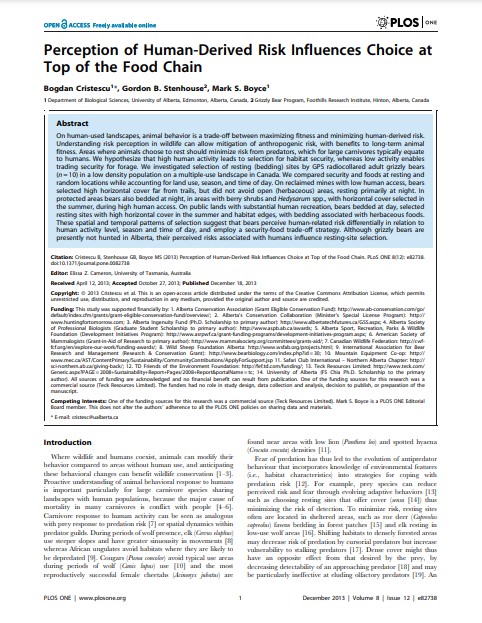Perception of human-derived risk influences choice at top of the food chain
Bosque Modelo:
Foothills
Temática:
Gestión forestal
Tipo de documento:
Artículo científico
Resumen
On human-used landscapes, animal behavior is a trade-off between maximizing fitness and minimizing human-derived risk. Understanding risk perception in wildlife can allow mitigation of anthropogenic risk, with benefits to long-term animal fitness. Areas where animals choose to rest should minimize risk from predators, which for large carnivores typically equate to humans. We hypothesize that high human activity leads to selection for habitat security, whereas low activity enables trading security for forage. We investigated selection of resting (bedding) sites by GPS radiocollared adult grizzly bears
(n = 10) in a low density population on a multiple-use landscape in Canada. We compared security and foods at resting and random locations while accounting for land use, season, and time of day. On reclaimed mines with low human access, bears selected high horizontal cover far from trails, but did not avoid open (herbaceous) areas, resting primarily at night. In protected areas bears also bedded at night, in areas with berry shrubs and Hedysarum spp., with horizontal cover selected in the summer, during high human access. On public lands with substantial human recreation, bears bedded at day, selected resting sites with high horizontal cover in the summer and habitat edges, with bedding associated with herbaceous foods. These spatial and temporal patterns of selection suggest that bears perceive human-related risk differentially in relation to human activity level, season and time of day, and employ a security-food trade-off strategy. Although grizzly bears are presently not hunted in Alberta, their perceived risks associated with humans influence resting-site selection.
Información Bibliográfica
Autor:
Cristescu, B., Stenhouse, G.B., Boyce, M.S.
Revista:
PLoS ONE
Año:
2013
N°:
12
País :
Canadá
Páginas:
-
Volumen:
8
Idioma:
Ingles
Palabras claves
Model forest, Adaptatation, perception, Impact, food





